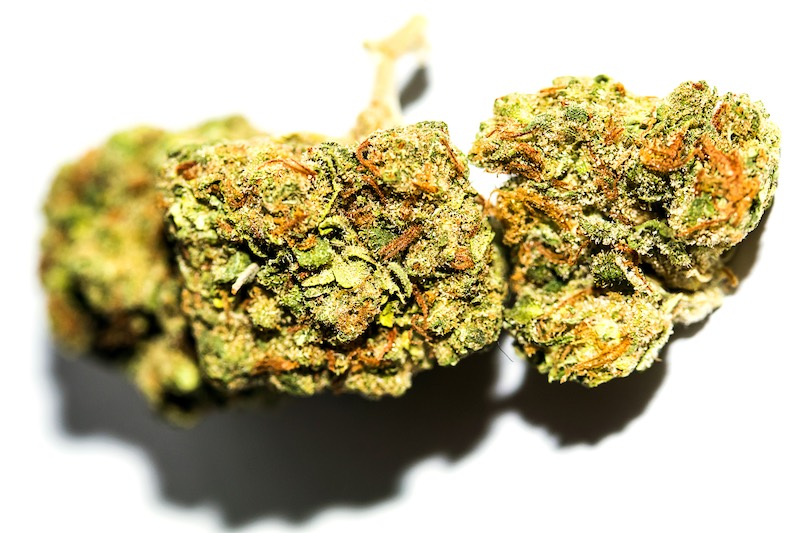- What happens if a dog or cat accidentally eats “raw” marijuana?
- What if my pet eats an edible?
- I just caught my pet eating cannabis. What should I do next?
- What are the signs that my pet is under the influence of cannabis?
- I’ve just taken my pet to the vet after ingesting cannabis—what should I expect?
- Is veterinary treatment resulting from cannabis consumption covered by pet insurance?
- If my vet says I don’t need to bring my pet in, how can I keep them comfortable at home until they sober up?
- Can my pet be in the room with me while I smoke cannabis?
- Could CBD be beneficial to my pet?
- Is catnip related to cannabis?
Cannabis is becoming more widely decriminalized in the U.S.—if not outright legalized for recreational use—with regulated dispensaries making it safer to take a puff (or a nibble).
While you might know how to handle those indica flowers or sativa chocolates, your four-legged friend is another story. What happens if they accidentally make their way into your stash?
We spoke to Dr. Stephanie Liff, Lemonade’s expert veterinarian, to address some of the most commonly asked questions surrounding pets and cannabis.
What happens if a dog or cat accidentally eats “raw” marijuana?
According to Dr. Liff, if your cat or dog eats cannabis flowers, stems, or seeds, you probably shouldn’t be too concerned—but a vet visit might still be in order.
“Cannabis is not a fatal toxin in dogs and cats,” Dr. Liff assures, “but it can cause respiratory depression—slowed breathing—which can require hospitalization.” (FYI, she says it’s rare that cats will try to eat weed in the first place.)
“In pets, marijuana ingestion causes lethargy, nodding-off type behavior, and sometimes nausea,” explains Dr. Liff. “In severe cases, if the nausea and the lethargy are present together, you have an increased risk of aspiration pneumonia. [This is] a dangerous phenomenon in which your pet can inhale their own vomit—but again, it’s very rare.”
In humans, eating weed in its raw form has little to no physical or psychoactive effects, so why does it pack such a punch if a cat or dog scarfs down a few buds?

Well, cannabis contains 100 cannabinoid chemicals, including THC and CBD. Dogs and cats have more cannabinoid receptors in their brains than humans do, which means they are at risk for marijuana toxicity, even if they haven’t eaten a large amount. The more your pet eats relative to their body weight, the more severe their reaction will be.
What if my pet eats an edible?
Edibles are a more efficient and concentrated way to deliver both THC and CBD into the bloodstream. If you sprinkle flakes of pot into your cereal, nothing much will happen—but the way edibles are prepared makes it possible to get high simply by ingesting a baked good or gummy bear.

In addition to the cannabis toxicity, edibles such as brownies or chocolates come with the double danger of both THC and chocolate, which is highly toxic to both dogs and cats. And edibles like gummies are loaded with sugar or fruit juices that could be harmful to your pet; if they incorporate artificial sweeteners, that’s an additional toxicity risk.
Even if your pet didn’t consume a dangerous amount of cannabis, the supplementary ingredients of the edible alone might warrant a trip to the vet.
I just caught my pet eating cannabis. What should I do next?
If we’re talking about a dog, you can try to induce vomiting, says Dr. Liff. This is not advisable for cats (but again, felines are less apt to eat cannabis in the first place).
“Ideally, you should try to force your dog to vomit before they start to feel the effects,” advises Dr. Liff. Generally, those effects will kick in around 30–60 minutes after ingestion. Vomiting can be induced by giving your pet hydrogen peroxide, using appropriate dosing for their body weight. There’s also a prescription eye drop for dogs, Clevor, that’s meant to induce vomiting.
If you’ve missed that window, and your pet is starting to look or act pretty… stoned, Dr. Liff would suggest a concerned pet parent jump on a call with their vet, who’ll “discuss the clinical signs you’re observing, so they can gauge if your pet can ride it out at home—or if hospitalization is warranted.”
Cannabis can also cause a decreased or increased respiratory rate in pets. This is rare, but these symptoms require immediate veterinary attention. If you observe your pet’s breathing has dramatically slowed or increased, it’s time to go to the emergency vet.
Keep in mind that vets are not narcs! Even if cannabis is not legal where you live, your dog or cat’s doctor is not going to ring up the DEA to report you. Be transparent and comfortable sharing all details with your vet, so that they have the full context of what’s going on with your pet.
Be honest with your vet about what your pet ate, how much of it they ate, and if there is any risk the cannabis has been laced with another drug or substance.
If your dog or cat ate a synthetic faux-marijuana product—the kind available over-the-counter at smoke shops and other stores—you might want to err on the side of caution, since the ingredients in those concoctions are notoriously unpredictable.
This helps your vet give your pet the best possible care. Do not skip a call or trip to the vet to avoid your vet’s judgment—they just want what’s best for your pet.
What are the signs that my pet is under the influence of cannabis?
An intoxicated pet will have a similar reaction to cannabis as humans do, but to a much greater extreme.
Your pet will likely be very sleepy, have dilated pupils, be wobbly and dizzy, drool, and might urinate on themselves or vomit. Woof.

As we mentioned previously, cannabis can also cause a decreased or increased respiratory rate in pets. If you notice this happening, head to the emergency vet.
I’ve just taken my pet to the vet after ingesting cannabis—what should I expect?
“Typically we administer Cerenia to help with any nausea,” explains Dr. Liff, “and sometimes we administer SQ and IV fluids to keep them hydrated.”
After your pooch or kitty is all set up, Dr. Liff gives them time to chill and receive supportive care. “We allow these pets to rest,” she says, “usually in a dark and quiet environment.”
Is veterinary treatment resulting from cannabis consumption covered by pet insurance?
Yes, as long as it’s a one-off incident!
Vet-recommended diagnostics, treatments, and medications after your pet accidentally ingests cannabis will be covered by a Lemonade Pet accident & illness policy. Lemonade’s vet visit fee add-on could also cover the cost of your vet’s time and attention.
But there’s an important caveat.
If your dog or cat gets into your cannabis multiple times, your pet insurance might file these instances as a recurring, preventable occurrence, meaning your pet’s treatments for cannabis ingestion might no longer be covered by pet insurance.
We know that you love your pets, and we also know that shit happens sometimes. If your pet manages to get cannabis once, consider investing in some safety precautions, like a secure box to store cannabis supplies at home.
If you leave pot and paraphernalia on your coffee table while you’re binge-watching Adult Swim, you’re asking for trouble. It’s possible to indulge and keep your furry friends safe.
If my vet says I don’t need to bring my pet in, how can I keep them comfortable at home until they sober up?
If your fur baby is having a “bad trip,” time is their best friend.
“Just let them sleep,” encourages Dr. Liff. “Check if they’re vomiting or urinating themselves, and keep them clean and dry.”
In addition, Dr. Liff advises you to keep your four-legged bestie clear of stairs, swimming pools, balconies, or other treacherous places in and around your home.
Since cannabis compromises your pet’s sense of balance, you will want to be extra careful to keep them out of harm’s way until the cannabis has worked its way through their system, which will take anywhere from 18 to 24 hours (!).
Can my pet be in the room with me while I smoke cannabis?
“Yes, it’s totally safe to smoke around your pets,” assures Dr. Liff, “but smoke can be irritating to pets—as it can be to pet owners.”
For your own health, as well as your fur fam, hitting the bong in an unventilated living room isn’t very advisable. As always, exercise common sense (which probably means thinking ahead before you puff).
Could CBD be beneficial to my pet?
Maybe.
While CBD benefits aren’t conclusive, some research suggests that CBD can manage chronic pain and improve cardiac function in your pet. It may also have cancer-fighting properties, help control seizures, and make allergic dogs feel less itchy, among other benefits. Ask your vet if you think CBD could provide some relief to your pet.
Since CBD is still in its experimental phases, it’s not covered by Lemonade Pet Insurance.
Is catnip related to cannabis?
Nope. But that doesn’t stop cheeky brands from capitalizing on the confusion (we think these catnip “Meowijuana” products are pretty cute.)
Cannabis is a part of the Cannabaceae family, which includes hemp, hops, nettle trees, and hackberry. Catnip is a member of the Lamiaceae family, which includes rosemary oregano, sage, thyme, and lavender (catnip is lovely in a tea blend!).
Catnip produces a euphoric response in 70–80% of house cats through inhalation, whereas THC or CBD from marijuana products are absorbed in humans through the lungs, GI tract, or topically through the skin.
Smoking catnip has been reported to have calming effects in humans (nothing like the “zoomies” cats get), but you definitely should not try to get your cat high with recreational marijuana. Or your dog. Or your iguana. Or any animal living with you who’ll be confused and distressed by the experience.
A few quick words, because we <3 our lawyers: This post is general in nature, and any statement in it doesn’t alter the terms, conditions, exclusions, or limitations of policies issued by Lemonade, which differ according to your state of residence. You’re encouraged to discuss your specific circumstances with your own professional advisors. The purpose of this post is merely to provide you with info and insights you can use to make such discussions more productive! Naturally, all comments by, or references to, third parties represent their own views, and Lemonade assumes no responsibility for them. Coverage and discounts may not be available in all states.




